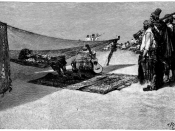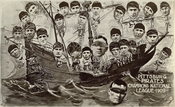The Age of Piracy came almost 200 years after Columbus had sighted the Bahamas, and lasted until about 1722. Although it was a brief period, it was filled with pirates, and scoundrels of every kind. All of them attempting to acquire wealth and vast riches. The Pirates ranged their travels from Madagascar to the eastern coast of North America, trading their stolen goods to whoever would deal. Pirates had many affects on 15th century Europe; some positive, but also some were negative.
Piracy is an illegal robbery committed on a ship at sea; it is very hard to tell the difference between a pirate and a privateer. Privateers unlike pirates have a letter of marquee from the king or queen of their country, so therefore they are backed or protected by them. Privateers will only attack vessels of an enemy country. A pirate will attack ships of all nations. "Piracy is robbery committed or attempted on the high seas.
It is distinguished from privateering in that the pirate holds no commission from and receives the protection of no nation but usually attacks vessels of all nations" (Piracy). A privateer would steal the goods on a ship and then give a portion of that back to the country they were backed by. The king or queen would then take the stolen money and act as if nothing happened.
Piracy became more abundant when the Age of Exploration came along in the 1500's. Portugal and Spain were very superior navies compared to the rest of Europe. In 1494 the Pope divided the New World between Spain and Portugal. This did not go over well with the other European nations. They wanted a part of the gold the Spanish were stealing from the Aztecs. When these countries sent sailors out to explore,



Pirates
hm...so the pirates were nicely protrayed in the pirates of the carribean! I mean they were dead, mean and dirty too. The thought of pirates disgusts me now...
0 out of 0 people found this comment useful.